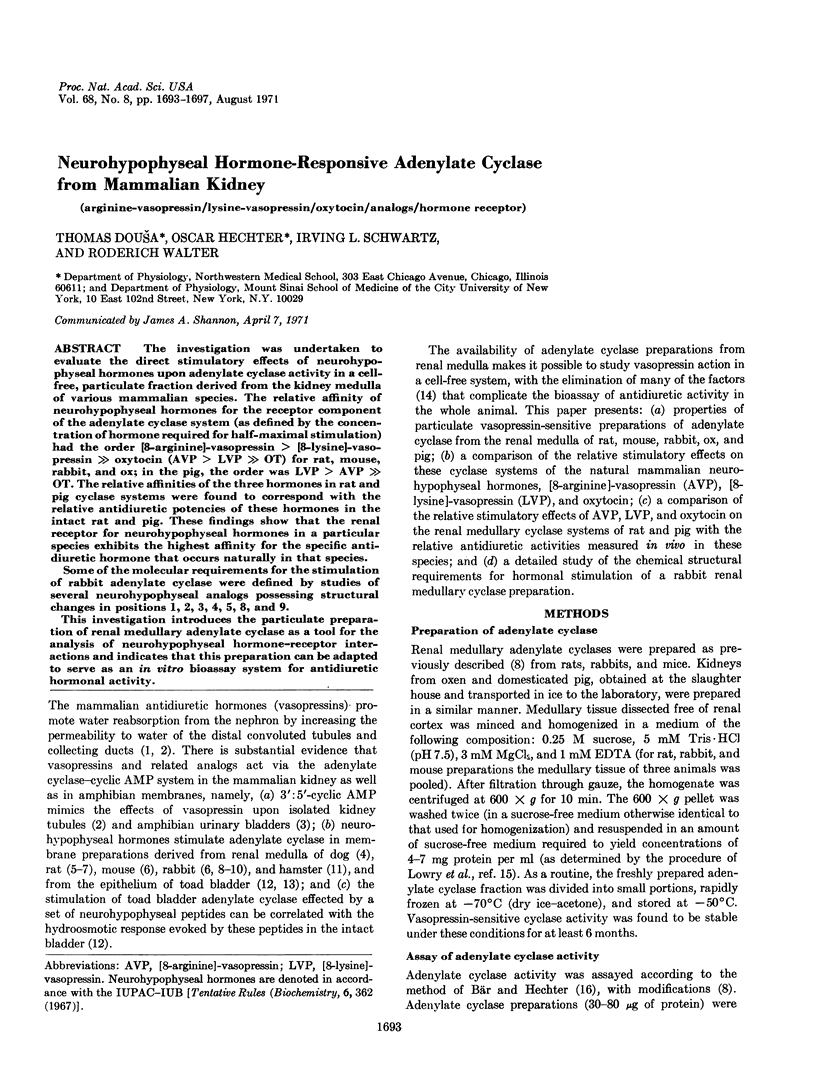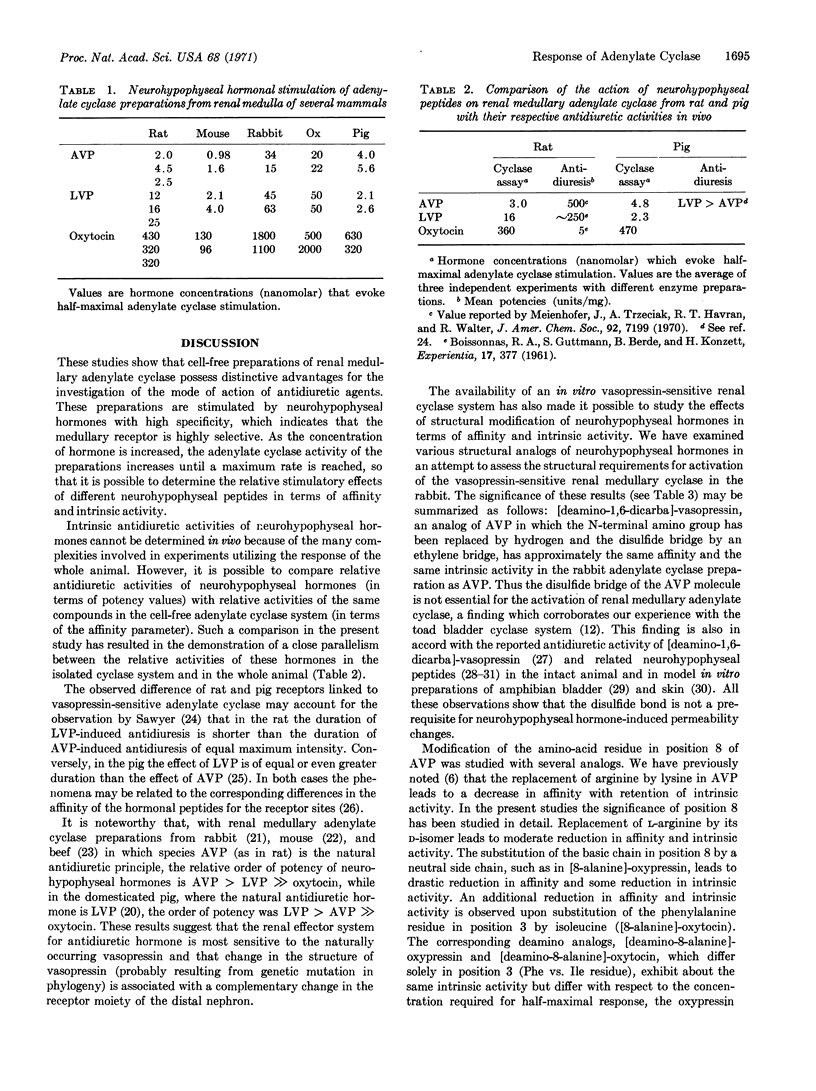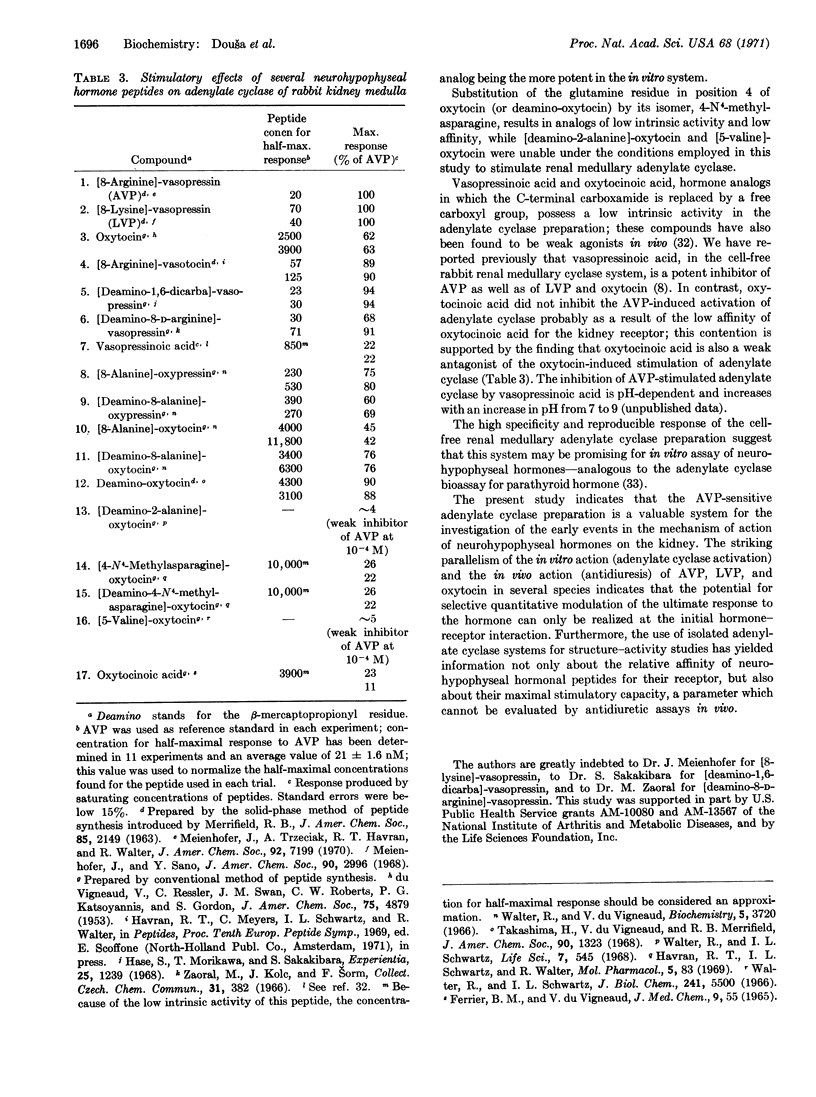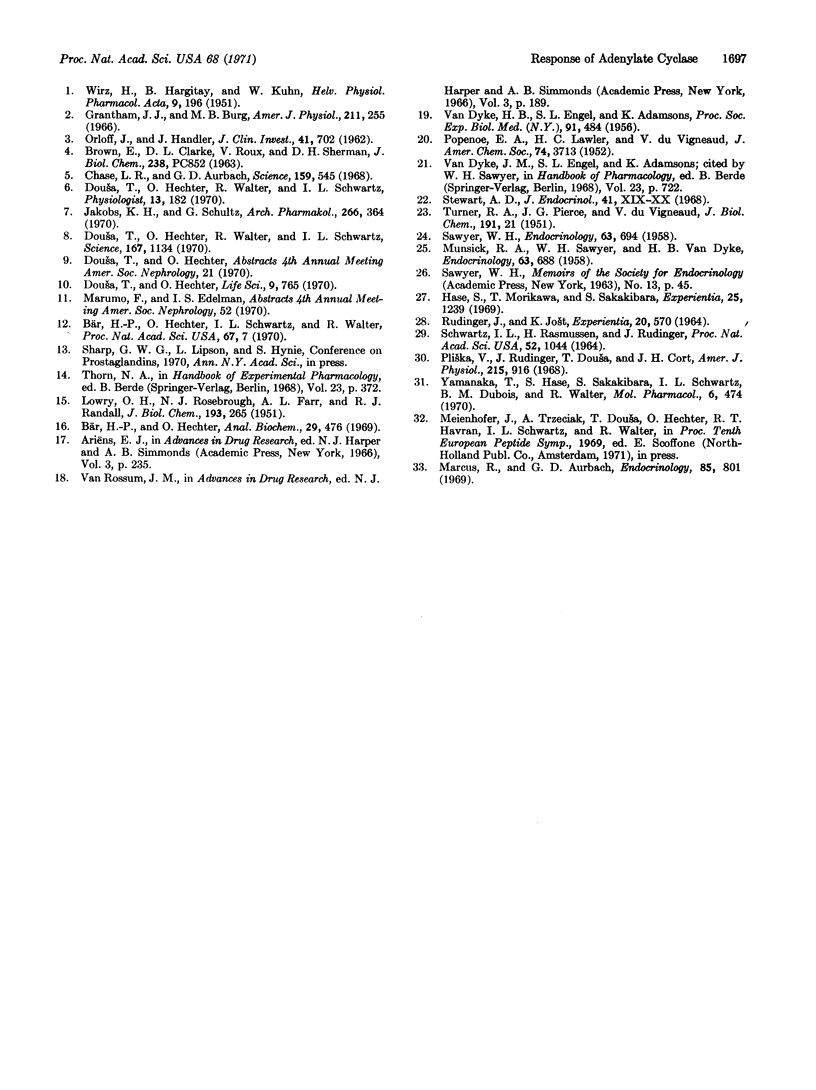Abstract
The investigation was undertaken to evaluate the direct stimulatory effects of neurohypophyseal hormones upon adenylate cyclase activity in a cell-free, particulate fraction derived from the kidney medulla of various mammalian species. The relative affinity of neurohypophyseal hormones for the receptor component of the adenylate cyclase system (as defined by the concentration of hormone required for half-maximal stimulation) had the order [8-arginine]-vasopressin > [8-lysine]-vasopressin ≫ oxytocin (AVP > LVP ≫ OT) for rat, mouse, rabbit, and ox; in the pig, the order was LVP > AVP ≫ OT. The relative affinities of the three hormones in rat and pig cyclase systems were found to correspond with the relative antidiuretic potencies of these hormones in the intact rat and pig. These findings show that the renal receptor for neurohypophyseal hormones in a particular species exhibits the highest affinity for the specific antidiuretic hormone that occurs naturally in that species.
Some of the molecular requirements for the stimulation of rabbit adenylate cyclase were defined by studies of several neurohypophyseal analogs possessing structural changes in positions 1, 2, 3, 4, 5, 8, and 9.
This investigation introduces the particulate preparation of renal medullary adenylate cyclase as a tool for the analysis of neurohypophyseal hormone-receptor interactions and indicates that this preparation can be adapted to serve as an in vitro bioassay system for antidiuretic hormonal activity.
Keywords: arginine-vasopressin, lysine-vasopressin, oxytocin, analogs, hormone receptor
Full text
PDF




Selected References
These references are in PubMed. This may not be the complete list of references from this article.
- Bär H. P., Hechter O. Adenyl cyclase assay in fat cell ghosts. Anal Biochem. 1969 Jun;29(3):476–489. doi: 10.1016/0003-2697(69)90332-7. [DOI] [PubMed] [Google Scholar]
- Bär H. P., Hechter O., Schwartz I. L., Walter R. Neurohypophyseal hormone-sensitive adenyl cyclase of toad urinary bladder. Proc Natl Acad Sci U S A. 1970 Sep;67(1):7–12. doi: 10.1073/pnas.67.1.7. [DOI] [PMC free article] [PubMed] [Google Scholar]
- Chase L. R., Aurbach G. D. Renal adenyl cyclase: anatomically separate sites for parathyroid hormone and vasopressin. Science. 1968 Feb 2;159(3814):545–547. doi: 10.1126/science.159.3814.545. [DOI] [PubMed] [Google Scholar]
- Dousa T., Hechter O. The effect of NaCl and LiCl on vasopressin-sensitive adenyl cyclase. Life Sci I. 1970 Jul 1;9(13):765–770. doi: 10.1016/0024-3205(70)90286-9. [DOI] [PubMed] [Google Scholar]
- Dousa T., Hechter O., Walter R., Schwartz I. L. [8-Arginine]-vasopressinoic acid: an inhibitor of rabbit kidney adenyl cyclase. Science. 1970 Feb 20;167(3921):1134–1135. doi: 10.1126/science.167.3921.1134. [DOI] [PubMed] [Google Scholar]
- Grantham J. J., Burg M. B. Effect of vasopressin and cyclic AMP on permeability of isolated collecting tubules. Am J Physiol. 1966 Jul;211(1):255–259. doi: 10.1152/ajplegacy.1966.211.1.255. [DOI] [PubMed] [Google Scholar]
- Hase S., Morikawa T., Sakakibara S. Synthesis of a biologically active analog of deamino-8-arginine-vasopressin which does not contain a disulphide bond. Experientia. 1969 Dec 15;25(12):1239–1240. doi: 10.1007/BF01897469. [DOI] [PubMed] [Google Scholar]
- Jakobs K. H., Schultz G. Wirkungen verschiedener Hormone und Pharmaka auf die Adenyl-Cyclase der Rattenniere. Naunyn Schmiedebergs Arch Pharmakol. 1970;266(4):364–365. [PubMed] [Google Scholar]
- LOWRY O. H., ROSEBROUGH N. J., FARR A. L., RANDALL R. J. Protein measurement with the Folin phenol reagent. J Biol Chem. 1951 Nov;193(1):265–275. [PubMed] [Google Scholar]
- MUNSICK R. A., SAWYER W. H., VAN DYKE H. B. The antidiuretic potency of arginine and lysine vasopressins in the pig with observations on porcine renal function. Endocrinology. 1958 Nov;63(5):688–693. doi: 10.1210/endo-63-5-688. [DOI] [PubMed] [Google Scholar]
- Marcus R., Aurbach G. D. Bioassay of parathyroid hormone in vitro with a stable preparation of adenyl cyclase from rat kidney. Endocrinology. 1969 Nov;85(5):801–810. doi: 10.1210/endo-85-5-801. [DOI] [PubMed] [Google Scholar]
- Meienhofer J., Sano Y. A solid-phase synthesis of [lysine]-vasopressin through a crystalline protected nonapeptide intermediate. J Am Chem Soc. 1968 May 22;90(11):2996–2997. doi: 10.1021/ja01013a067. [DOI] [PubMed] [Google Scholar]
- Meienhofer J., Trzeciak A., Havran R. T., Walter R. A solid-phase synthesis of (8-arginine)-vasopressin through a crystalline protected nonapeptide intermediate and biological properties of the hormone. J Am Chem Soc. 1970 Dec 2;92(24):7199–7202. doi: 10.1021/ja00727a031. [DOI] [PubMed] [Google Scholar]
- ORLOFF J., HANDLER J. S. The similarity of effects of vasopressin, adenosine-3',5'-phosphate (cyclic AMP) and theophylline on the toad bladder. J Clin Invest. 1962 Apr;41:702–709. doi: 10.1172/JCI104528. [DOI] [PMC free article] [PubMed] [Google Scholar]
- Pliska V., Rudinger J., Dousa T., Cort J. H. Oxytocin activity and the integrity of the disulfide bridge. Am J Physiol. 1968 Oct;215(4):916–920. doi: 10.1152/ajplegacy.1968.215.4.916. [DOI] [PubMed] [Google Scholar]
- Rudinger J., Jost K. A biologically active analogue of oxytocin not containing a disulfide group. Experientia. 1964 Oct 15;20(10):570–571. doi: 10.1007/BF02150299. [DOI] [PubMed] [Google Scholar]
- SAWYER W. H. Differences in the antidiuretic responses of rats to the intravenous administration of lysine and arginine vasopressins. Endocrinology. 1958 Nov;63(5):694–698. doi: 10.1210/endo-63-5-694. [DOI] [PubMed] [Google Scholar]
- SCHWARTZ I. L., RASMUSSEN H., RUDINGER J. ACTIVITY OF NEUROHYPOPHYSIAL HORMONE ANALOGUES LACKING A DISULFIDE BRIDGE. Proc Natl Acad Sci U S A. 1964 Oct;52:1044–1045. doi: 10.1073/pnas.52.4.1044. [DOI] [PMC free article] [PubMed] [Google Scholar]
- TURNER R. A., PIERCE J. G., du VIGNEAUD V. The purification and the amino acid content of vasopressin preparations. J Biol Chem. 1951 Jul;191(1):21–28. [PubMed] [Google Scholar]
- Takashima H., Du Vigneaud V., Merrifield R. B. The synthesis of deamino-oxytocin by the solid phase method. J Am Chem Soc. 1968 Feb 28;90(5):1323–1325. doi: 10.1021/ja01007a038. [DOI] [PubMed] [Google Scholar]
- VAN DYKE H. B., ENGEL S. L., ADAMSONS K., Jr Comparison of pharmacological effects of lysine and arginine vasopressins. Proc Soc Exp Biol Med. 1956 Mar;91(3):484–486. doi: 10.3181/00379727-91-22300. [DOI] [PubMed] [Google Scholar]
- WIRZ H., HARGITAY B., KUHN W. Lokalisation des Konzentrierungsprozesses in der Niere durch direkte Kryoskopie. Helv Physiol Pharmacol Acta. 1951 Jun;9(2):196–207. [PubMed] [Google Scholar]
- Walter R., Schwartz I. L. 5-Valine-oxytocin and 1-deamino-5-valine-oxytocin. Syntheses and some pharmacological properties. J Biol Chem. 1966 Dec 10;241(23):5500–5503. [PubMed] [Google Scholar]
- Yamanaka T., Hase S., Sakakibara S., Schwartz I. L., Dubois B. M., Walter R. Crystalline deamino-dicarba-oxytocin. Preparation and some pharmacological properties. Mol Pharmacol. 1970 Sep;6(5):474–480. [PubMed] [Google Scholar]


